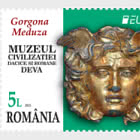Romfilatelia, the company specialized in editing and trading Romanian postage stamps, introduces into circulation the philatelic issue 110 years since the Foundation of the Romanian Savings Bank Palace.
On the place where the monumental building of the Romanian Savings Bank Palace is built stood the famous Saint John the Great Monastery, a 16th century foundation of the Buzesti. Between 1702 and 1703, the ruler Constantin Brancoveanu restored it, thus becoming the last founder of the monastic institution. In time it was damaged and as a consequence, the monastery was demolished at the end of the 19th century.
In the presence of the King Carol I and Queen Elizabeth, on June 8th 1897, the foundation stone of the Palace was placed. Along with the royal family, the members of the government lead by Dimitrie A. Sturza, Ion C. Bratianu, the Minister of the Public Works Department, G. Cantacuzino, the minister of the Finances Department and C.F. Robescu, the mayor of Bucharest, also participated. The works, initiated in the spring of 1895, were finalized in 1900. The project plans of the Palace bear the signature of the French architect Paul Gottereau, a graduate of the School of Arts in Paris, and the execution was entrusted to the contractor Ion Socolescu.
With obvious specific elements of the late 19th century French academism, the Romanian Savings Bank Palace shortly becomes the image with which the institution will be identified. Well proportioned, the building has a symmetrical facade in the middle of which the entrance is opened, highlighted by a monumental arcade in the exact centre of the city, supported on both sides by two twin columns, in composite style. The four corner volumes, decorated with frontons and coats of arms, are covered with domes nuilt in Renaissance style. A bigger dome covers the Central Hallway of the building, in which until 1999, Romanian Savings Bank counters have operated. A special attention has been granted to the Council Hall, located on the upper floor of the Palace, with a ceiling painted by the artist Michel Simonidy, representing „Fortuna dividing her goods after obtaining the Independence“. The canvas with the same theme has been exhibited at the
International Exhibition in Paris, in 1900, in the Romanian pavilion, obtaining the first silver medal. On the side walls of the Council Hall there are four monumental paintings, representing King Carol I, Queen Elizabeth, King Ferdinand I and Queen Marie, works of art restored by the painter Valentin Tanase in 2005, after the original paintings of Michel Simonidy and professor Costin Petrescu (destroyed in 1948).
The judicious decoration of the facades and the balance of the volumes make this Palace an interesting architectural monument of Bucharest, the old „Little Paris“ from the East.
The issue is completed by 1 maxicard.












































